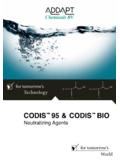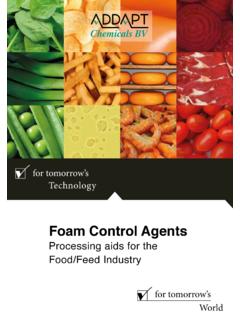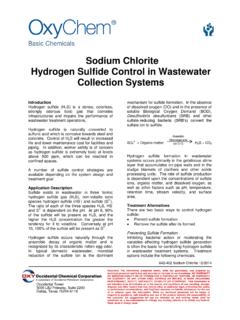Transcription of Wastewater Treatment Additives - ADDAPT …
1 Chemicals BV. for tomorrow's Technology Wastewater Treatment Additives for tomorrow's World 2. Contents 1. Introduction 2. 2. Water Treatment methods 3. Mechanical-chemical Treatment 3. Biological Treatment 3. 3. Industrial sewage system set-up 3. 4. Wastewater pre- Treatment 3. 5. Pre-settle 3. 6. Biological stage 4. Surface aeration 4. Submerged aeration 4. Tower biology 4. Other aeration techniques 4. 7. Final sedimentation 4. 8. Foam Control Agents 5. Foam Control Agent usage 5. Selection of Foam Control Agents 5. 9. Scaling and Anti-scalants 5. 10. Conclusion 7. 11. Selection guide 8. 3. 1. Introduction Natural Increasing living standard and consumption of goods is followed by the increase of waste products. This implies that water supply and Wastewater Treatment obtain high priority for all kind of industries.
2 In order to keep up with fresh water supply, usage of Wastewater Treatment plants became a standard practise for the majority of the industries producing considerable amount of Wastewater . During purification of the Wastewater , there is an increasing tendency of foam-build up. Usage of Foam Control Agents is highly recommended in order to achieve an optimised Wastewater Treatment process. The increasing number of waste Treatment plants and the very strict environmental restrictions for industrial waste leads to a strong increase in Foam Control Agents (FCA). The composition of Wastewater varies dramatic and it is advised to split the Wastewater in industrial applications. Industrial Wastewater again, differs strongly from communal Wastewater . Communal Wastewater consists mainly of non-ionic and anionic surfactants.
3 Because of the high diluting factor, the communal Wastewater does show a high foam tendency. This in contrast to the industrial Wastewater , which shows a high concentration of industrial waste, dissolved in the water. The increase in foam tendency of industrial Wastewater can be found in: Larger Wastewater quantities;. Higher content of foaming substances in the Wastewater ;. Biodegradation becomes more difficult; therefore more intensive Treatment is required. The chemical industry consumes the highest amount of water (one third of the fresh water consumption). About 80% of this fresh water is used for cooling processes. The chemical process takes 16% of the used water in account and only 2% is used as boiling feed water and drinking water for employees. Chemical industries that produce and/or handle emulsions based systems and industries handling methyl cellulose do produce Wastewater with a strong foam tendency.
4 Running a Wastewater Treatment plant is not an easy task because of the different kind of chemicals dissolved in the Wastewater . Adequate inoculums have to be selected enabling one to biodegrade the chemicals dissolved in the Wastewater . The composition of the industrial Wastewater also alters many times. This asks for a fast change in Treatment of the Wastewater . For this reason there are many different Wastewater Treatment processes available. A correct choice of the Treatment leads to a very effective biodegradation of the chemicals. Below the most well known Treatment processes are discussed in brief. 4. 2. Water Treatment methods Mechanical-chemical Treatment Solids have been removed from the Wastewater and water was collected in large basins in order to allow solids to settle to the bottom.
5 This was the version of a Wastewater Treatment plant. Later, flocculants were used in order to improve the settling of the solids and a better clarification was achieved. This (very simple) Treatment of Wastewater is still in use. Biological Treatment Majority of industries is using a so-called biological clarification in combination with the mechanical- chemical Treatment . The biological Treatment is a foam active process and requires Foam Control Agents. The principle is the same as applied in fresh water and seas: micro organism use the pollution as nutrient and produce by using oxygen (aerobic) cell substances and carbon dioxide or without oxygen (anaerobic) manure gas (methane). Water Treatment plants apply the aerobic process. Sometime a combination of both methods is applied. The supply of oxygen can be achieved in different ways.
6 The most convenient and easiest way is by stirring. The stir process adds also to the foam tendency. The presence of oxygen is, of course, the key to an optimised biodegradation process. 3. Industrial sewage system set-up The communal sewage plants are all similar because the Wastewater composition from this source is more or less the same. Industrial sewage systems can differ because the Wastewater composition often differs dramatic from each other, it depends what kind of industry is attached to the sewage system. In some cases the communal Wastewater and industrial Wastewater is pre-mixed with each other in order to keep the running cost low (no extra sewage system for the communal Wastewater ). In this case the composition of the Wastewater is also kept uniform; this is an advantage for the micro organism used in the sewage systems (adaptation of the micro-organism).
7 Industrial sewage systems consist of different treat stages: Pre- Treatment ;. Pre-settle;. Biological stage;. Final sedimentation. 4. Wastewater pre- Treatment Many chemical production processes include the usage of acids or lye. For this reason, the majority of the incoming Wastewater has to be neutralised first. The neutralisation takes part after the settling of the rough dirt has been collected. 5. Pre-settle The dissolved heavy metal will separate as hydroxides after the neutralisation reaction. These hydroxides are collected together with other solids during the so-called pre-settle process. The pre-settle process is carried out in pre-clarification ponds. The process can be accelerated by the usage of flocculants. The pre-clarified water is now pumped into the biological pond. During this pump activity, the water passes different kind of sieves and filters in order to filter out more, small sized solids.
8 5. 6. Biological stage The active sludge in the biological pond is responsible for the biodegradation. This biodegradation is mainly an aerobic process. There are many different ways to add oxygen to the biological pond in order to optimise the biodegradation. Surface aeration This is the most widely used process. The water goes in to ponds with a 3 to 4 m. depth. At the surface there are large stirrers (aerators), which produce a high turbulence. The turbulence leads a high amount of oxygen into the biological pond. This process leads to a high foam activity. In order to prevent a strong foam activity, the operators use Foam Control Agents. The stirrers are responsible for a good distribution of the Foam Control Agent. The usage of an active Foam Control Agent is critical because the presence of foam decreases the air supply dramatically.
9 Submerged aeration The ponds have a depth of 6 to 8 meters. The air supply is achieved via large nozzles, which blow air in the liquid. The advantage of this technique that the air distribution is more effective as in the previous mentioned method (stirring). This method also asks for an effective Foam Control Agent. Tower biology Tower-biology refers to the latest technology in Wastewater Treatment . The biodegradation takes place in steel containers, which measure 30 meters, height. The principle is similar to a fermentation tower for yeast production. Advantages of this technology are: Better oxygen utilisation;. Space saving construction;. Odourless process. The containers are closed. The produced gases and excess of oxygen are treated afterwards. Other aeration techniques A few other systems are in use; however, they never became common systems in the Wastewater Treatment process such as: second aeration stage droppers (towers filled with so-called droppers.)
10 Where the Wastewater is added from the top to the liquid stored in the Wastewater tower. All the above systems deal with standard air. In very special cases, pure oxygen is added to the Wastewater . It is obvious that these ponds are covered in order to keep the oxygen in the pond and a minimum will evaporate. 7. Final sedimentation The activated sludge and clarified Wastewater have to be separated after the biodegradation. The water is transferred into the final sedimentation ponds. Flocculants are added to the waste in order to accelerate the sedimentation process. A part of the activated sludge transferred back to the biological pond, the remaining sludge is de-watered and treated together with the primary sludge. A problem can occur when the sludge floats on top of water ponds, the entrapped air prohibits the settling of the sludge.










